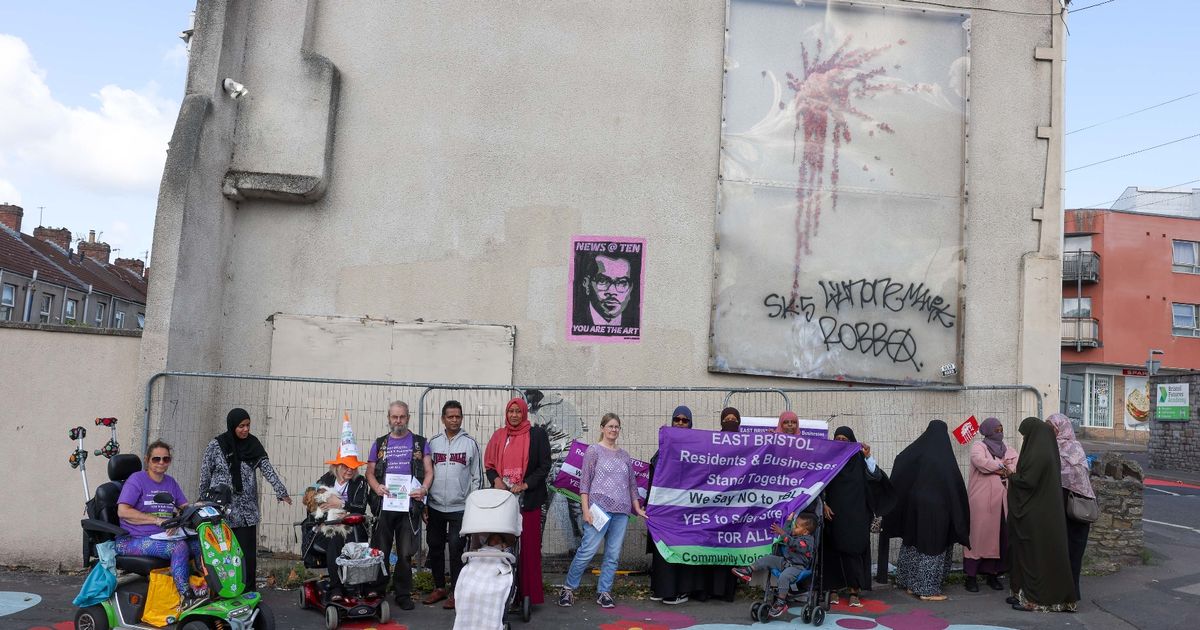The controversial six month trial is finally underway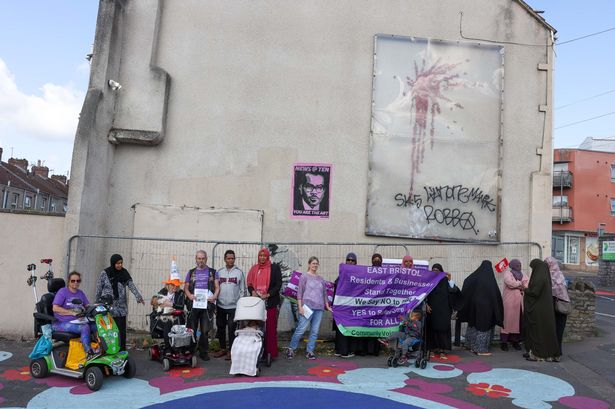 Residents protest against the new scheme as it went live on Monday, June 2(Image: PAUL GILLIS / Reach PLC)
Residents protest against the new scheme as it went live on Monday, June 2(Image: PAUL GILLIS / Reach PLC)
The group of local residents arrived on foot from all directions and greeted each other as familiar friends, but there was an air of desperation and exasperation in their greetings.
They gathered, as they had done many times before over the past eight months or so, in what is probably Barton Hill’s most famous spot – in front of Banksy’s 2021 Valentine’s Day mural, now sadly mostly covered over or itself graffitied.
The residents came from the nearby tower blocks, from out of nearby cafes and businesses and from slightly further afield in the terraced streets of Redfield.
For months they have gathered to visually and vocally protest against, campaign against and, on several occasions, physically stop the implementation of the East Bristol Liveable Neighbourhood (EBLN) in this corner of the affected area.
This week, however, was a day they didn’t want to arrive. They’d tried and ultimately failed to stop the creation of three bus gates on this corner, and now they were gathering in a visible protest on the morning those cameras were switched on.
And this corner of Marsh Lane and Avonvale Road is a key location in the area – the creation of pretty much the entire EBLN relies on prohibiting private car and van drivers from accessing this junction. To the south, down the hill of Marsh Lane is the Feeder canal and the main road out of Barton Hill across the bridge and away to the rest of the city.
To the east along Avonvale Road is Avonvale Cemetery, Netham Park, the streets of Redfield and St George and access to the east of the city. And to the west along the same road is the heart of Barton Hill, the council tower blocks, the Wellspring Settlement and home to thousands of people.
The EBLN zone has a bus gate on all three approaches now, so only a newly-created bus service, taxis, car drivers who have managed to secure an exemption from the city council, people on two wheels and, of course, pedestrians, can traverse this junction.
To say these bus gates are unpopular with some is an understatement. The road has been painted bright red, road signs were quickly vandalised, enforcement cameras erected were sprayed with black paint with the intention of blinding them.
Around the rest of the area, other strategic roads have been similarly blocked to car and van drivers albeit with ‘modal filters’ – large wooden planters bolted to the road that allow two wheels through but not four.
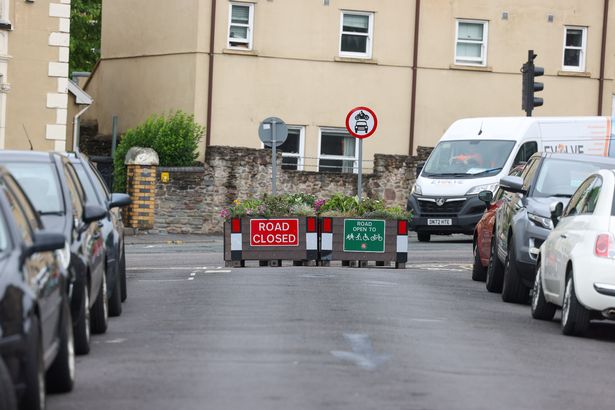 One of the East Bristol Liveable Neighbourhood ‘modal filters’ that turn residential roads in Redfield and St George into no-through roads for cars and vans(Image: PAUL GILLIS / Reach PLC)
One of the East Bristol Liveable Neighbourhood ‘modal filters’ that turn residential roads in Redfield and St George into no-through roads for cars and vans(Image: PAUL GILLIS / Reach PLC)
For some, it is a nightmare that has radically changed their every day life, although supporters say it has already brought calm to rat-run streets. Now it is a challenge, or pretty much impossible, to drive across or through the EBLN area, some local businesses who deliver locally are complaining. Ask any supermarket delivery driver what they think and you can visibly see their blood pressure rising.
“Disabled and elderly have already seen a drop in support networks,” said Melissa Topping, one of the faces of the anti-EBLN campaign. She said the impact on everyday life is already being felt in Barton Hill and Redfield, where those short car journeys around the area – the proclaimed target of the council – are increasingly difficult.
“I myself have had a huge drop in friends being able to pop in and help out. They no longer have time thanks to the traffic and detours. They can no longer pass easily on route to work or home. Now I’m having to pay carers for more help than previously. With carers also often now being late at no fault of their own.
“I am hearing from many others with the same problems. Families will no longer be able to collect elderly or disabled residents to take them for hospital and GP appointments with ease. Having to go the long way round to collect them, then again to get them to appointments, the same to get them home, and again to get themselves home, meaning this is unachievable in either a lunch break or small window,” she added.
On the local residents’ campaign Facebook group, photographs are shared and reports are made of ambulances having to turn around, of buses and fire engines getting stuck, delivery lorries struggling on the unfamiliar routes and corners.
READ MORE: Anger over new bus gates as residents in Bristol suburb say council has ‘failed in duty of care’READ MORE: East Bristol Liveable Neighbourhood has ‘brought calm to our streets’ say supporters
For many in Barton Hill who were initially opposed to the scheme, the way the council has gone about implementing it in the face of their opposition has been almost as bad, if not worse, than the scheme itself.
That culminated in a pre-dawn operation with police acting as bodyguards to a convoy of council contractors to install the last of the infrastructure, something the force later apologised for, and council leader Tony Dyer said he had ‘regrets’ about.
But while the corner of the Avonvale Road and Marsh Lane has been a lightning rod for those opposed to the scheme, the windows of Redfield tell a different story.
The windows of the Victorian terraces between the main Church Road and the park and the cemetery are dotted with campaign posters – but these are in favour of the Liveable Neighbourhood.
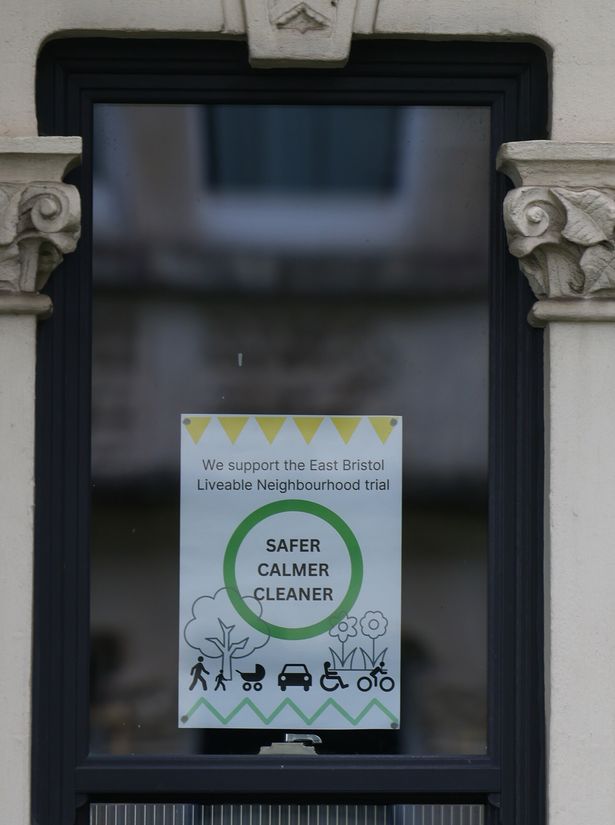 “Safer, Calmer, Cleaner” – posters in windows of homes in Redfield and St George where people support the East Bristol Liveable Neighbourhood trial(Image: PAUL GILLIS / Reach PLC)
“Safer, Calmer, Cleaner” – posters in windows of homes in Redfield and St George where people support the East Bristol Liveable Neighbourhood trial(Image: PAUL GILLIS / Reach PLC)
Many of those in favour told Bristol Live that they believed there was a quieter majority who were supportive of the scheme, or at least willing to see the trial out to assess what the difference would be.
“The trouble is, a lot of people see how loudly those against it shout, and how vociferous they are and keep their heads down. It can get quite nasty on social media,” said Angharad Hughes, who said she’s already noticing the positive effects of having no-through traffic in her local roads.
Her part of Redfield and St George is suddenly one big cul-de-sac effectively – albeit not the suburban sitcom type – created by a ‘modal filter’ at the end of Beaufort Road.
“I do understand the reservations of people in Barton Hill and maybe there will have to be changes there. I absolutely support the right to protest, it’s just such a shame that it’s been delayed all this time, and that we haven’t been able to get it started properly so we can all see what the effects are,” Angharad added.
Scratch a bit more into the arguments over the EBLN over the past year and deeper Bristol divides come uncomfortably to the surface. For many opposing the scheme, especially in Barton Hill, it feels like this is a class issue as well as one about traffic restrictions.
St George and Redfield’s Victorian terraces have been rapidly gentrified over the past few years – and its new population is far more likely to be more affluent, more able to cycle, not rely on a car and more prepared to embrace such radical intervention.
 Angaharad Hughes in her St George Bristol neighbourhood, Tuesday 3 June 2025 , where she is in favour of the new East Bristol Liveable Neighbourhood scheme(Image: PAUL GILLIS / Reach PLC)
Angaharad Hughes in her St George Bristol neighbourhood, Tuesday 3 June 2025 , where she is in favour of the new East Bristol Liveable Neighbourhood scheme(Image: PAUL GILLIS / Reach PLC)
Barton Hill is one of the city’s most socio-economically deprived areas, and has one of the lowest levels of car ownership in the city. But people there are more likely to be working class, in jobs that need a car to get to.
Some on the extreme end of the campaign frame the debate and the EBLN itself as some kind of class-cleansing with a younger, richer, more eco-friendly middle class community imposing an unwanted scheme on the council estates they live next door to. It’s no coincidence that when the bus gate signs appeared on Avonvale Road, someone sprayed ‘No poor people allowed’ on both of them.
Those in favour of the scheme say they tend to see it more about challenging the mindset of the car driver who thinks they have a right to drive anywhere, even to cut through residential streets to avoid traffic jams on the main road.
“This area feels dominated by traffic, and the response by some drivers to the EBLN is scary,” said Pete Brooks, who lives on Avonvale Road in the heart of Barton Hill, but is in favour of the trial project.
“Seeing drivers cutting over pavements and tyre tracks over graves makes me fearful of how drivers will act, especially in rush hour traffic. I don’t feel safe cycling on Avonvale Road or Marsh Lane, so I now take a tricky off-road route instead.
“I have had drivers beep and shout at me when I’ve signalled and slowed down to turn onto a side road. I’ve been passed within a few centimetres by cars speeding despite there being no one else on the road.
“I was shouted at by a van driver, who revved their engine to intimidate me – this was after he pulled out dangerously onto the main road in front of me. When we were both cycling, my partner was almost hit by a car speeding and cutting a corner, this driver then shouted at my partner in response.
READ MORE: Parents say East Bristol Liveable Neighbourhood makes roads ‘100 times safer’ for childrenREAD MORE: Opposition to controversial East Bristol Liveable Neighbourhood ‘will filter away’ say council bosses
“Despite Avonvale Road and Marsh Lane being a 20mph zone, I’m always surprised to see someone sticking to the limit. We’ve seen two flipped cars in a year, and lots more broken bollards and dented cars. We’ve seen cars race each other in the night and can often hear cars speeding over the speed bump outside our house.
“I’m deeply concerned for the safety of children, families and elderly people crossing the road to access Netham Park – the main green space for Barton Hill and play area for Redfield. There are no crossings that prioritise pedestrians, and with the speed of traffic, I’d be wary of drivers stopping in time if there were,” he added.
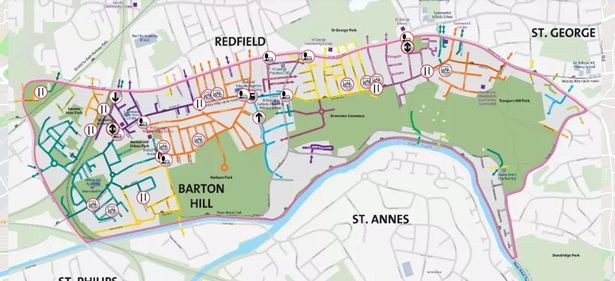 A map of the east Bristol liveable neighbourhood scheme(Image: Bristol City Council)
A map of the east Bristol liveable neighbourhood scheme(Image: Bristol City Council)
“I’ve been desperately waiting for the bus gates to be switched on, and to see what change the trial might make. I’m aware that the design isn’t perfect and consultation of the scheme could have been much better. It feels so depressing that some people won’t even let the trial happen, that they keep moving planters and stealing bollards, when it could make such a difference to our safety as cyclists, and my own mental health.
“I’ve heard a lot of noise about drivers freedom but nothing about those who don’t drive – and this area has some of the lowest car ownership in Bristol. Lots of the traffic on our road seems to be commuters – it’s hardly fair when we have higher air pollution than areas further out of the city,” he added.
The bus gates will be fully operational from July 14 with motorists facing fines of up to £70, following the current ‘soft enforcement’ phase during which they will instead be sent a warning letter.
Last week Heather Mack, deputy council leader, said: “There is no doubt that for many people it will be a big change. We hope that, in combination with the other trial measures, the bus gates will help to make the streets safer and less polluted.”
